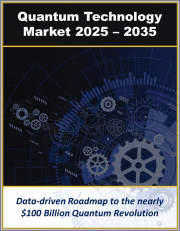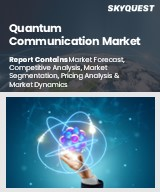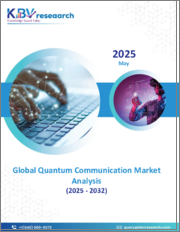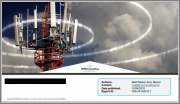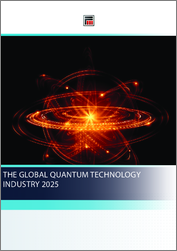
|
시장보고서
상품코드
1754848
세계의 양자 기술 산업(2025년) : 기술, 시장, 투자, 기회The Global Quantum Technology Industry 2025: Technologies, Markets, Investments and Opportunities |
||||||
2025년 1분기에는 양자 기술에 대한 투자가 현저하게 급증했고, 조달액은 12억 5,000만 달러를 넘어 2024년 1분기부터 125% 증가했습니다. 자자의 신뢰가 높아지고 있음을 보여주며, 자본이 적은 반면 유리한 입장에 있는 기업에 집약되어 있습니다.
주요 자금 조달 라운드는 다음과 같습니다.
- QuEra Computing : 2억 3,000만 달러의 시리즈 B(2025년 1분기 최대 라운드)
- IonQ : 3억 6,000만 달러의 주식 공개와 10억 7,500만 달러의 Oxford Ionics 인수
- Quantum Machines : 1억 7,000만 달러의 Series C 자금 조달
- D-Wave Systems : 1억 5,000만 달러의 주식 공개
IonQ는 인수 전략을 통해 양자 컴퓨팅 부문에서 가장 큰 전업 기업이 되어 이 부문의 리더로 부상하고 있습니다. Quantique 인수로 IonQ는 컴퓨팅 하드웨어에서 내양자 보안 솔루션에 이르기까지 여러 양자 시장 부문을 획득하게 됩니다. 퓨전을 통합한 양자 기술 스택으로 시장 발전를 반영하고 있습니다. 현재 알려진 양자 컴퓨팅 기업의 50% 이상이 주요 하드웨어와 컨트롤 팜 플랫폼을 이용하고 있으며, 이는 산업 표준화와 생태계의 성숙을 보여줍니다.
2025년에는 여러 가지 중요한 이정표가 있으며 양자 기술의 실용적인 잠재력이 입증되었습니다.
- Microsoft의 Majorana 1 칩은 내결함성 시스템에 사용되는 토폴로지컬 양자 아키텍처를 도입합니다.
- D-Wave의 재료 시뮬레이션에 있어서의 양자의 우위성의 실증은 종래의 슈퍼컴퓨터를 능가합니다.
이러한 성과는 양자노동력의 능력도 향상되어 상업개발을 가속화하는 기반이 되고 있습니다. Centre는 2035년 내량자 암호화 전환 스케줄을 책정하고, 중국은 2020-2024년에 세계의 양자 특허 출원 건수의 50% 이상을 차지하고 양자 특허 출원 건수를 선도했습니다.
2025년 2분기의 주요 투자는 다음과 같습니다.
- Quobly : 2,100만 유로
- Multiverse Computing : 1억 8,900만 유로(2억 1,500만 달러)
- Rigetti Computing : 3억 5,000만 달러(앳 더 마켓 제공 제품)
- Infleqtion Inc. : 1억 달러
투자자들 사이에서 양자 컴퓨팅은 AI에 이어 '다음 큰 것'이며 양자 기술은 의약품, 금융, 물류, 사이버 보안 등의 산업에 혁명을 일으키는 것으로 인식되고 있습니다. 등이 융합함에 따라 양자 기술부문은 2025년에 실험적인 장래성에서 상업적인 현실성으로 이행하는 것을 보여주고 있습니다.
본 보고서에서는 세계의 양자 기술 산업에 대해 조사했으며, 양자혁명이 이론적인 개념에서 상업적 현실로 진행하는 과정을 검증하고 양자컴퓨팅, 통신, 센싱, 신용도의 2046년까지 시장 기회를 분석했습니다.
목차
제1장 주요 요약
- 양자 기술 시장 : 투자 급증(2025년)
- 제1, 제2 양자혁명
- 현재 양자 기술 시장 상황
- 주요 발전
- 양자 기술의 투자 상황
- 총 시장 투자(2012-2025년)
- 기술별
- 기업별
- 지역별
- 세계 각국 정부의 대처와 자금
- 시장 동향(2020-2025년)
- 양자 기술 채용의 과제
제2장 양자 컴퓨팅
- 양자 컴퓨팅이란
- 동작 원리
- 기존 컴퓨팅 및 양자 컴퓨팅
- 양자 컴퓨팅 기술
- 기타 기술과의 경쟁
- 양자 알고리즘
- 하드웨어
- 소프트웨어
- 시장의 과제
- SWOT 분석
- 양자 컴퓨팅의 밸류체인
- 양자 컴퓨팅 시장과 용도
- 의약품
- 화학
- 운송
- 금융 서비스
- 기회 분석
- 기술 로드맵
제3장 양자화학과 AI
- 기술 설명
- 용도
- SWOT 분석
- 시장의 과제
- 시장 진출기업
- 기회 분석
- 기술 로드맵
제4장 양자 통신
- 기술 설명
- 유형
- 용도
- 양자 난수 생성기(QRNG)
- 양자 키 분배(QKD)
- 포스트 양자 암호화(PQC)
- 양자 동형 암호화
- 양자 순간이동
- 양자 네트워크
- 양자 메모리
- 양자 인터넷
- 시장 과제
- 시장 진출기업
- 기회 분석
- 기술 로드맵
제5장 양자 센서
- 기술 설명
- 시장과 기술의 과제
- 기회 분석
- 기술 로드맵
제6장 양자 전지
- 기술 설명
- 유형
- 용도
- SWOT 분석
- 시장의 과제
- 시장 진출기업
- 기회 분석
- 기술 로드맵
제7장 양자 기술용 재료
- 초전도체
- 포토닉스, 실리콘 포토닉스, 광학 부품
- 나노재료
제8장 세계 시장 분석
- 시장 맵
- 업계의 주요 기업
- 스타트업
- 주요 기술 기업
- 국가의 대처
- 세계 시장의 수익(2018-2046년)
- 양자 컴퓨팅
- 양자 센서
- QKD 시스템
제9장 기업 프로파일(기업 306사의 프로파일)
제10장 조사 방법
제11장 용어와 정의
제12장 참고문헌
KTH 25.07.02The first quarter of 2025 witnessed a remarkable surge in quantum technology investments, with over $1.25 billion raised-representing a 125% increase from Q1 2024. This funding acceleration demonstrates growing investor confidence in quantum commercialization, with capital consolidating around fewer but better-positioned companies. The market is expanding rapidly, driven by technological advancements in quantum computing, sensing, and communications.
Major funding rounds include:
- QuEra Computing: $230 million Series B (largest Q1 2025 round)
- IonQ: $360 million equity offering plus $1.075 billion acquisition of Oxford Ionics
- Quantum Machines: $170 million Series C funding
- D-Wave Systems: $150 million equity offering
IonQ emerges as the sector leader, becoming the largest pure-play quantum computing company through its acquisition strategy. The company's $1.075 billion acquisition of Oxford Ionics, combined with its acquisition of Swiss quantum encryption provider ID Quantique, positions IonQ to capture multiple quantum market segments from computing hardware to quantum-safe security solutions. This consolidation trend reflects the market's evolution toward integrated quantum technology stacks, combining hardware, software, control systems, and cybersecurity solutions. Over 50% of known quantum computing companies now utilize platforms from leading hardware and control firms, indicating industry standardization and ecosystem maturation.
Several significant milestones in 2025 validate quantum technology's practical potential:
- Microsoft's Majorana 1 chip introduces topological quantum architecture for fault-tolerant systems
- D-Wave's quantum supremacy demonstration in materials simulation outperforms classical supercomputers
These achievements, combined with improving quantum workforce capabilities, create the foundation for accelerated commercial deployment. Government backing remains crucial, with $44.5 billion in cumulative public funding and $3.1 billion added in 2024. The UK's National Cyber Security Centre established a 2035 timeline for post-quantum cryptography migration, while China leads quantum patent filings with over 50% of global quantum patents between 2020-2024.
Major investments in Q2 2025 include:
- Quobly: Euro-21 million ($23.7m)
- Multiverse Computing: Euro-189 million ($215 million)
- Rigetti Computing: $350 million through an at-the-market stock offering
- Infleqtion Inc.: $100 million.
Investors increasingly recognizes quantum computing as "the next big thing" following artificial intelligence, with quantum technologies positioned to revolutionize industries from pharmaceuticals and finance to logistics and cybersecurity. The convergence of breakthrough research achievements, massive investment inflows, corporate acquisition strategies, and government regulatory support indicates that 2025 marks the quantum technology sector's transition from experimental promise to commercial reality. The quantum technology industry stands at an inflection point where theoretical potential meets practical application, making it one of the most compelling investment opportunities in the emerging technology landscape.
"The Global Quantum Technology Industry 2025" report delivers an authoritative analysis of the rapidly evolving quantum technology landscape, providing essential intelligence for investors, technology leaders, and strategic decision-makers navigating this transformative sector. This comprehensive 460-page market study examines the quantum revolution's progression from theoretical concepts to commercial reality, analyzing market opportunities by 2046 across quantum computing, communications, sensing, and emerging applications.
The report begins with a detailed examination of quantum technologies' surge in investment during 2025, highlighting the transition from the first quantum revolution (fundamental physics) to the second quantum revolution (practical applications). Key developments include breakthrough achievements in fault-tolerant quantum computing, widespread deployment of quantum key distribution networks, and the emergence of quantum sensors in commercial applications.
Report contents include:
- Quantum Computing:
- Eight quantum computing architectures: superconducting, trapped ion, silicon spin, topological, photonic, neutral atom, diamond-defect, and quantum annealing systems
- Comprehensive qubit technology assessment with coherence times, error rates, and scalability analysis
- Quantum software stack development including algorithms, machine learning, simulation, optimization, and cryptography applications
- Market size projections
- Industry applications across pharmaceuticals, chemicals, transportation, and financial services
- Quantum Chemistry and Artificial Intelligence:
- Integration of quantum computing with AI for molecular simulation and drug discovery
- Applications in materials science, battery technology, chemical engineering, and agriculture
- Market opportunities from $0.26 billion (2025) to $28.08 billion (2046)
- Technology roadmap covering small molecule simulations to ecosystem-level modeling
- Key players analysis
- Quantum Communications Infrastructure:
- Quantum Random Number Generators (QRNG) for cryptographic applications and gaming systems
- Quantum Key Distribution (QKD) systems for ultra-secure government and enterprise communications
- Post-quantum cryptography standardization and enterprise migration strategies
- Quantum networks, teleportation, and quantum internet infrastructure development
- Quantum Sensing Technologies:
- Atomic clocks for precision timing, GPS-independent navigation, and telecommunications synchronization
- Quantum magnetometers for medical imaging (MEG), geological surveys, and submarine detection
- Gravitational sensors for earthquake prediction, underground resource mapping, and infrastructure monitoring
- Quantum gyroscopes for autonomous vehicle navigation, aerospace applications, and inertial measurement
- Quantum imaging sensors for medical diagnostics, astronomical observations, and security surveillance
- Quantum radar systems for stealth aircraft detection, weather monitoring, and space debris tracking
- Quantum Batteries and Energy Storage:
- Revolutionary energy storage paradigm leveraging quantum superposition and entanglement
- Applications across electric vehicles, consumer electronics, grid storage, and aerospace systems
- Technology development from theoretical validation to commercial viability
- Ultra-fast charging capabilities and extended energy density advantages
- Advanced Materials for Quantum Technologies:
- Superconductors enabling quantum computing hardware and sensor applications
- Photonic components and silicon photonics for quantum communication systems
- Nanomaterials supporting quantum dot development and device miniaturization
- Materials science innovations driving quantum technology breakthroughs
- Supply chain analysis and manufacturing considerations
- Global Market Analysis and Investment Intelligence:
- Regional investment analysis across North America, Asia-Pacific, and Europe
- Technology roadmaps extending through 2046 with milestone predictions and inflection points
- SWOT analyses for each quantum technology sector identifying strengths, weaknesses, opportunities, and threats
- Market challenges assessment including technical barriers, cost considerations, and adoption timelines
- Investment landscape mapping covering venture capital, government funding, and corporate R&D spending
The quantum technology industry features an extensive ecosystem of over 300 companies including A* Quantum, AbaQus, Absolut System, Adaptive Finance Technologies, Aegiq, Agnostiq GmbH, Algorithmiq Oy, Airbus, Alea Quantum, Alpine Quantum Technologies GmbH (AQT), Alice&Bob, Aliro Quantum, Anametric Inc., Anyon Systems Inc., Aqarios GmbH, Aquark Technologies, Archer Materials, Arclight Quantum, Arctic Instruments, Arqit Quantum Inc., ARQUE Systems GmbH, Artificial Brain, Artilux, Atlantic Quantum, Atom Computing, Atom Quantum Labs, Atomionics, Atos Quantum, Baidu Inc., BEIT, Bleximo, BlueQubit, Bohr Quantum Technology, Bosch Quantum Sensing, BosonQ Ps, C12 Quantum Electronics, Cambridge Quantum Computing (CQC), CAS Cold Atom, Cerca Magnetics, CEW Systems Canada Inc., Chipiron, Chiral Nano AG, Classiq Technologies, ColibriTD, Covesion, Crypta Labs Ltd., CryptoNext Security, Crystal Quantum Computing, D-Wave Systems, Dirac, Diraq, Delft Circuits, Delta g, Duality Quantum Photonics, EeroQ, eleQtron, Element Six, Elyah, Entropica Labs, Ephos, Equal1.labs, EuQlid, Groove Quantum, EvolutionQ, Exail Quantum Sensors, EYL, First Quantum Inc., Fujitsu, Genesis Quantum Technology, GenMat, Good Chemistry, Google Quantum AI, g2-Zero, Haiqu, Hefei Wanzheng Quantum Technology Co. Ltd., High Q Technologies Inc., Horizon Quantum Computing, HQS Quantum Simulations, HRL, Huayi Quantum, IBM, Icarus Quantum, Icosa Computing, ID Quantique, InfinityQ, Infineon Technologies AG, InfiniQuant, Infleqtion, Intel, IonQ, ISARA Corporation, IQM Quantum Computers, JiJ, JoS QUANTUM GmbH, KEEQuant GmbH, KETS Quantum Security, Ki3 Photonics, Kipu Quantum, Kiutra GmbH, Kuano Limited, Kvantify, levelQuantum, Ligentec, LQUOM, Lux Quanta, M Squared Lasers, Mag4Health, MagiQ Technologies, Materials Nexus, Maybell Quantum Industries, memQ, Menlo Systems GmbH, Menten AI, Mesa Quantum, MicroAlgo, Microsoft, Mind Foundry, Miraex, Molecular Quantum Solutions, Montana Instruments, Mphasis, Multiverse Computing, Mycryofirm, Nanofiber Quantum Technologies and more.....
TABLE OF CONTENTS
1. EXECUTIVE SUMMARY
- 1.1. Quantum Technologies Market in 2025: Surge in Investment
- 1.2. First and second quantum revolutions
- 1.3. Current quantum technology market landscape
- 1.3.1. Key developments
- 1.4. Quantum Technologies Investment Landscape
- 1.4.1. Total market investments 2012-2025
- 1.4.2. By technology
- 1.4.3. By company
- 1.4.4. By region
- 1.4.4.1. The Quantum Market in North America
- 1.4.4.2. The Quantum Market in Asia
- 1.4.4.3. The Quantum Market in Europe
- 1.5. Global government initiatives and funding
- 1.6. Market developments 2020-2025
- 1.7. Challenges for quantum technologies adoption
2. QUANTUM COMPUTING
- 2.1. What is quantum computing?
- 2.1.1. Operating principle
- 2.1.2. Classical vs quantum computing
- 2.1.3. Quantum computing technology
- 2.1.3.1. Quantum emulators
- 2.1.3.2. Quantum inspired computing
- 2.1.3.3. Quantum annealing computers
- 2.1.3.4. Quantum simulators
- 2.1.3.5. Digital quantum computers
- 2.1.3.6. Continuous variables quantum computers
- 2.1.3.7. Measurement Based Quantum Computing (MBQC)
- 2.1.3.8. Topological quantum computing
- 2.1.3.9. Quantum Accelerator
- 2.1.4. Competition from other technologies
- 2.1.5. Quantum algorithms
- 2.1.5.1. Quantum Software Stack
- 2.1.5.2. Quantum Machine Learning
- 2.1.5.3. Quantum Simulation
- 2.1.5.4. Quantum Optimization
- 2.1.5.5. Quantum Cryptography
- 2.1.5.5.1. Quantum Key Distribution (QKD)
- 2.1.5.5.2. Post-Quantum Cryptography
- 2.1.6. Hardware
- 2.1.6.1. Qubit Technologies
- 2.1.6.1.1. Superconducting Qubits
- 2.1.6.1.1.1. Technology description
- 2.1.6.1.1.2. Materials
- 2.1.6.1.1.3. Market players
- 2.1.6.1.1.4. Swot analysis
- 2.1.6.1.2. Trapped Ion Qubits
- 2.1.6.1.2.1. Technology description
- 2.1.6.1.2.2. Materials
- 2.1.6.1.2.2.1. Integrating optical components
- 2.1.6.1.2.2.2. Incorporating high-quality mirrors and optical cavities
- 2.1.6.1.2.2.3. Engineering the vacuum packaging and encapsulation
- 2.1.6.1.2.2.4. Removal of waste heat
- 2.1.6.1.2.3. Market players
- 2.1.6.1.2.4. Swot analysis
- 2.1.6.1.3. Silicon Spin Qubits
- 2.1.6.1.3.1. Technology description
- 2.1.6.1.3.2. Quantum dots
- 2.1.6.1.3.3. Market players
- 2.1.6.1.3.4. SWOT analysis
- 2.1.6.1.4. Topological Qubits
- 2.1.6.1.4.1. Technology description
- 2.1.6.1.4.1.1. Cryogenic cooling
- 2.1.6.1.4.2. Market players
- 2.1.6.1.4.3. SWOT analysis
- 2.1.6.1.4.1. Technology description
- 2.1.6.1.5. Photonic Qubits
- 2.1.6.1.5.1. Technology description
- 2.1.6.1.5.2. Market players
- 2.1.6.1.5.3. Swot analysis
- 2.1.6.1.6. Neutral atom (cold atom) qubits
- 2.1.6.1.6.1. Technology description
- 2.1.6.1.6.2. Market players
- 2.1.6.1.6.3. Swot analysis
- 2.1.6.1.7. Diamond-defect qubits
- 2.1.6.1.7.1. Technology description
- 2.1.6.1.7.2. SWOT analysis
- 2.1.6.1.7.3. Market players
- 2.1.6.1.8. Quantum annealers
- 2.1.6.1.8.1. Technology description
- 2.1.6.1.8.2. SWOT analysis
- 2.1.6.1.8.3. Market players
- 2.1.6.1.1. Superconducting Qubits
- 2.1.6.2. Architectural Approaches
- 2.1.6.1. Qubit Technologies
- 2.1.7. Software
- 2.1.7.1. Technology description
- 2.1.7.2. Cloud-based services- QCaaS (Quantum Computing as a Service).
- 2.1.7.3. Market players
- 2.2. Market challenges
- 2.3. SWOT analysis
- 2.4. Quantum computing value chain
- 2.5. Markets and applications for quantum computing
- 2.5.1. Pharmaceuticals
- 2.5.1.1. Market overview
- 2.5.1.1.1. Drug discovery
- 2.5.1.1.2. Diagnostics
- 2.5.1.1.3. Molecular simulations
- 2.5.1.1.4. Genomics
- 2.5.1.1.5. Proteins and RNA folding
- 2.5.1.2. Market players
- 2.5.1.1. Market overview
- 2.5.2. Chemicals
- 2.5.2.1. Market overview
- 2.5.2.2. Market players
- 2.5.3. Transportation
- 2.5.3.1. Market overview
- 2.5.3.2. Market players
- 2.5.4. Financial services
- 2.5.4.1. Market overview
- 2.5.4.2. Market players
- 2.5.1. Pharmaceuticals
- 2.6. Opportunity analysis
- 2.7. Technology roadmap
3. QUANTUM CHEMISTRY AND ARTIFICAL INTELLIGENCE (AI)
- 3.1. Technology description
- 3.2. Applications
- 3.3. SWOT analysis
- 3.4. Market challenges
- 3.5. Market players
- 3.6. Opportunity analysis
- 3.7. Technology roadmap
4. QUANTUM COMMUNICATIONS
- 4.1. Technology description
- 4.2. Types
- 4.3. Applications
- 4.4. Quantum Random Numbers Generators (QRNG)
- 4.4.1. Overview
- 4.4.2. Applications
- 4.4.2.1. Encryption for Data Centers
- 4.4.2.2. Consumer Electronics
- 4.4.2.3. Automotive/Connected Vehicle
- 4.4.2.4. Gambling and Gaming
- 4.4.2.5. Monte Carlo Simulations
- 4.4.3. Advantages
- 4.4.4. Principle of Operation of Optical QRNG Technology
- 4.4.5. Non-optical approaches to QRNG technology
- 4.4.6. SWOT Analysis
- 4.5. Quantum Key Distribution (QKD)
- 4.5.1. Overview
- 4.5.2. Asymmetric and Symmetric Keys
- 4.5.3. Principle behind QKD
- 4.5.4. Why is QKD More Secure Than Other Key Exchange Mechanisms?
- 4.5.5. Discrete Variable vs. Continuous Variable QKD Protocols
- 4.5.6. Key Players
- 4.5.7. Challenges
- 4.5.8. SWOT Analysis
- 4.6. Post-quantum cryptography (PQC)
- 4.6.1. Overview
- 4.6.2. Security systems integration
- 4.6.3. PQC standardization
- 4.6.4. Transitioning cryptographic systems to PQC
- 4.6.5. Market players
- 4.6.6. SWOT Analysis
- 4.7. Quantum homomorphic cryptography
- 4.8. Quantum Teleportation
- 4.9. Quantum Networks
- 4.9.1. Overview
- 4.9.2. Advantages
- 4.9.3. Role of Trusted Nodes and Trusted Relays
- 4.9.4. Entanglement Swapping and Optical Switches
- 4.9.5. Multiplexing quantum signals with classical channels in the O-band
- 4.9.5.1. Wavelength-division multiplexing (WDM) and time-division multiplexing (TDM)
- 4.9.6. Twin-Field Quantum Key Distribution (TF-QKD)
- 4.9.7. Enabling global-scale quantum communication
- 4.9.8. Advanced optical fibers and interconnects
- 4.9.9. Photodetectors in quantum networks
- 4.9.9.1. Avalanche photodetectors (APDs)
- 4.9.9.2. Single-photon avalanche diodes (SPADs)
- 4.9.9.3. Silicon Photomultipliers (SiPMs)
- 4.9.10. Cryostats
- 4.9.10.1. Cryostat architectures
- 4.9.11. Infrastructure requirements
- 4.9.12. Global activity
- 4.9.12.1. China
- 4.9.12.2. Europe
- 4.9.12.3. The Netherlands
- 4.9.12.4. The United Kingdom
- 4.9.12.5. US
- 4.9.12.6. Japan
- 4.9.13. SWOT analysis
- 4.10. Quantum Memory
- 4.11. Quantum Internet
- 4.12. Market challenges
- 4.13. Market players
- 4.14. Opportunity analysis
- 4.15. Technology roadmap
5. QUANTUM SENSORS
- 5.1. Technology description
- 5.1.1. Quantum Sensing Principles
- 5.1.2. SWOT analysis
- 5.1.3. Atomic Clocks
- 5.1.3.1. High frequency oscillators
- 5.1.3.1.1. Emerging oscillators
- 5.1.3.2. Caesium atoms
- 5.1.3.3. Self-calibration
- 5.1.3.4. Optical atomic clocks
- 5.1.3.4.1. Chip-scale optical clocks
- 5.1.3.5. Companies
- 5.1.3.6. SWOT analysis
- 5.1.3.1. High frequency oscillators
- 5.1.4. Quantum Magnetic Field Sensors
- 5.1.4.1. Introduction
- 5.1.4.2. Motivation for use
- 5.1.4.3. Market opportunity
- 5.1.4.4. Superconducting Quantum Interference Devices (Squids)
- 5.1.4.4.1. Applications
- 5.1.4.4.2. Key players
- 5.1.4.4.3. SWOT analysis
- 5.1.4.5. Optically Pumped Magnetometers (OPMs)
- 5.1.4.5.1. Applications
- 5.1.4.5.2. Key players
- 5.1.4.5.3. SWOT analysis
- 5.1.4.6. Tunneling Magneto Resistance Sensors (TMRs)
- 5.1.4.6.1. Applications
- 5.1.4.6.2. Key players
- 5.1.4.6.3. SWOT analysis
- 5.1.4.7. Nitrogen Vacancy Centers (N-V Centers)
- 5.1.4.7.1. Applications
- 5.1.4.7.2. Key players
- 5.1.4.7.3. SWOT analysis
- 5.1.5. Quantum Gravimeters
- 5.1.5.1. Technology description
- 5.1.5.2. Applications
- 5.1.5.3. Key players
- 5.1.5.4. SWOT analysis
- 5.1.6. Quantum Gyroscopes
- 5.1.6.1. Technology description
- 5.1.6.1.1. Inertial Measurement Units (IMUs)
- 5.1.6.1.2. Atomic quantum gyroscopes
- 5.1.6.2. Applications
- 5.1.6.3. Key players
- 5.1.6.4. SWOT analysis
- 5.1.6.1. Technology description
- 5.1.7. Quantum Image Sensors
- 5.1.7.1. Technology description
- 5.1.7.2. Applications
- 5.1.7.3. SWOT analysis
- 5.1.7.4. Key players
- 5.1.8. Quantum Radar
- 5.1.8.1. Technology description
- 5.1.8.2. Applications
- 5.1.9. Quantum Chemical Sensors
- 5.1.9.1. Technology overview
- 5.1.9.2. Commercial activities
- 5.1.10. Quantum Radio Frequency Field Sensors
- 5.1.10.1. Overview
- 5.1.10.2. Rydberg Atom Based Electric Field Sensors and Radio Receivers
- 5.1.10.2.1. Principles
- 5.1.10.2.2. Commercialization
- 5.1.10.3. Nitrogen-Vacancy Centre Diamond Electric Field Sensors and Radio Receivers
- 5.1.10.3.1. Principles
- 5.1.10.3.2. Applications
- 5.1.10.4. Market
- 5.1.11. Quantum NEM and MEMs
- 5.1.11.1. Technology description
- 5.2. Market and technology challenges
- 5.3. Opportunity analysis
- 5.4. Technology roadmap
6. QUANTUM BATTERIES
- 6.1. Technology description
- 6.2. Types
- 6.3. Applications
- 6.4. SWOT analysis
- 6.5. Market challenges
- 6.6. Market players
- 6.7. Opportunity analysis
- 6.8. Technology roadmap
7. MATERIALS FOR QUANTUM TECHNOLOGIES
- 7.1. Superconductors
- 7.1.1. Overview
- 7.1.2. Types and Properties
- 7.1.3. Opportunities
- 7.2. Photonics, Silicon Photonics and Optical Components
- 7.2.1. Overview
- 7.2.2. Types and Properties
- 7.2.3. Opportunities
- 7.3. Nanomaterials
- 7.3.1. Overview
- 7.3.2. Types and Properties
- 7.3.3. Opportunities
8. GLOBAL MARKET ANALYSIS
- 8.1. Market map
- 8.2. Key industry players
- 8.2.1. Start-ups
- 8.2.2. Tech Giants
- 8.2.3. National Initiatives
- 8.3. Global market revenues 2018-2046
- 8.3.1. Quantum computing
- 8.3.2. Quantum Sensors
- 8.3.3. QKD systems








